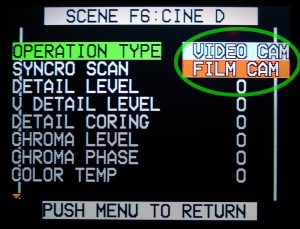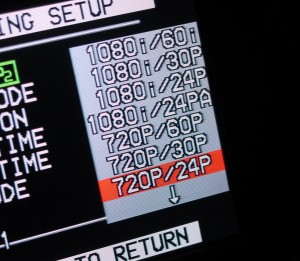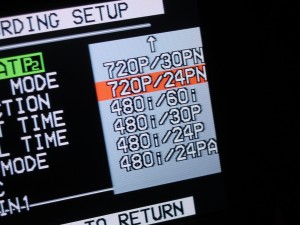 Features
Features
Panasonic P2 & The Notion of Slow Motion
Achieving a slow (or fast) motion effect in Panasonic P2 cameras is relatively straightforward. In HPX170 and HVX200 models, shooters select the operational type of a film or video camera. In Video Camera mode the camcorder enables such functions as time lapse, single frame animation and a three second HD pre-record. In Film Camera mode at 720p the variable frame rate function enables shooters to capture scenes from 12-60 FPS.

Choose Your Weapon: Video or Film. The Film Camera allows shooters to capture frame rates from 12-60 FPS.
Undercranking or overcranking a P2 camera is accomplished in either “native” mode where only active frames are recorded, or “over 60” where 60 frames per second are captured in all cases (à la Varicam). The “over 60” approach produces a 59.94 FPS timeline in the NLE so it’s important when shooting off speed to select 24pN or 30pN “native”recording if a 23.98 or 29.97 timeline is desired. This is the case when utilizing other manufacturers’ cameras on the same project, shooting 23.98 PsF in the Sony XDCAM HD and EX models to match the 24pN frame rate in P2. Selecting the correct flavor of 24p or 30p during capture will avoid the unnecessary rendering and loss of image quality when mixing native and non-native “over 60” footage on the same timeline. In P2 cameras variable speed frame rates can be achieved in either recording mode, however,at 24p or 24pN, 30p or 30pN.
We don’t normally think of frame rate as a key storytelling tool but it most assuredly is! Frame rate and story go hand in hand, the tempo of our images parading before the viewer varying in cadence and potentially adding drama or humor. Second only to focus in the shooter’s bag of tricks the ability to vary frame rate is critical to one’s storytelling. On many shoots I vary the frame rate on nearly every shot, tweaking a scene by one or two frames per second for maximum impact. This level of control is one of the great attributes of P2 cameras. We can’t obviously vary frame rate in most dialogue scenes, but even there in a character’s reaction I may alter the frame rate slightly to add weight to his or her performance.
Beyond tweaking actors’ performances I regularly use a range of cranking speeds in subtle ways, for example, when shooting a mood piece I will overcrank by 20% to impart a faint dream-like quality. Conversely if shooting a car chase I will undercrank by two or three frames per second to increase the apparent speed and peril of the pursuit. In either case the effect is restrained, and the viewer is quite unaware of the manipulation.


